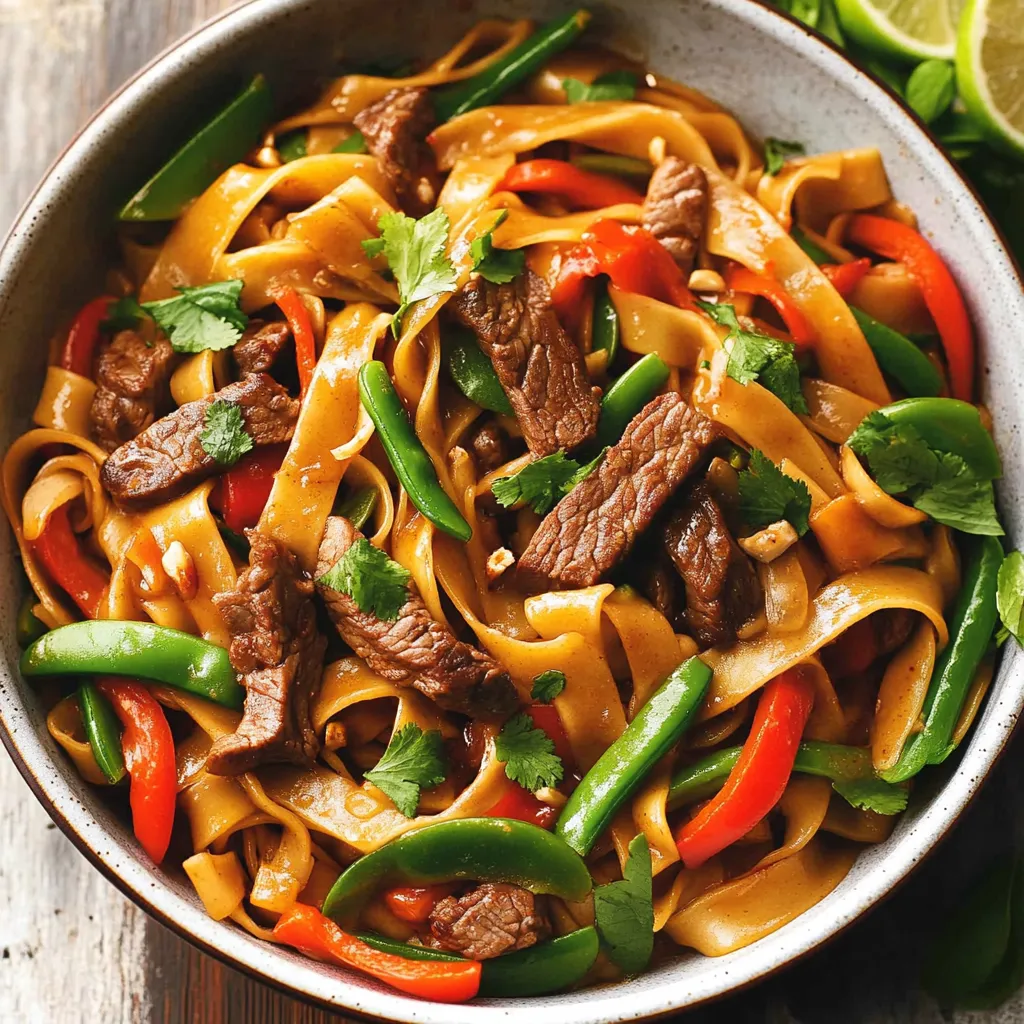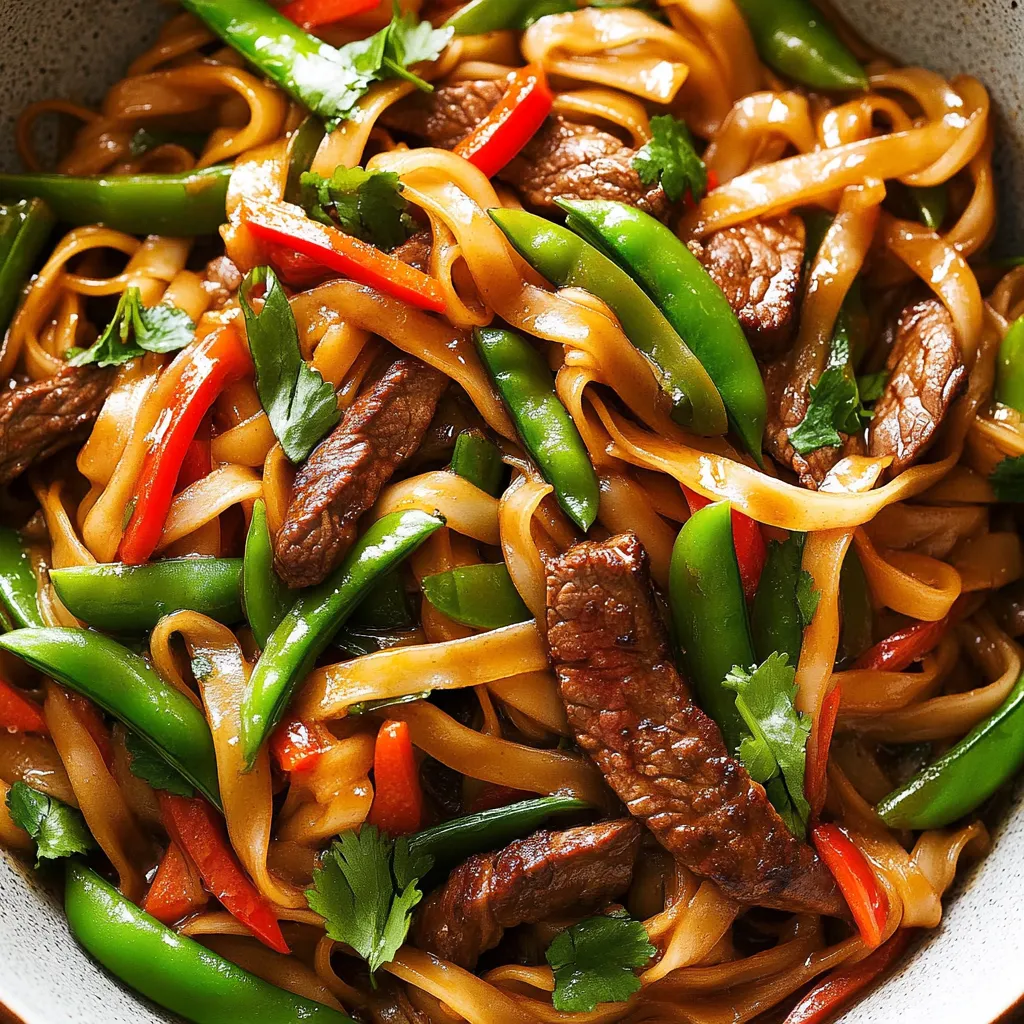 Pin it
Pin it
The intoxicating aroma of spicy, savory Thai Drunken Noodles will transport your senses straight to the bustling streets of Bangkok. This restaurant-favorite dish combines wide, chewy rice noodles with tender slices of beef and crisp vegetables, all enveloped in a complex sauce that perfectly balances sweet, salty, and spicy flavors. Ready in just 30 minutes, this homemade version delivers all the authentic taste of your favorite Thai restaurant with ingredients you can easily find and customize to your preference.
The first time I made these drunken noodles at home, my partner—who typically insists on ordering Thai takeout from our favorite spot—looked up after his first bite and simply said, "We don't need to order out anymore." The combination of chewy noodles, tender meat, and that signature sauce with its complex layers of flavor creates a truly crave-worthy meal that's surprisingly simple to prepare at home.
Ingredients That Make All The Difference
- Wide rice noodles: The broad surface area absorbs the flavorful sauce while maintaining that signature chewy texture. Look for fresh ones in Asian markets or dried ones in most grocery stores.
- Oyster sauce: Provides that distinctive umami richness that forms the backbone of the sauce. Don't skip this—it's what gives authentic depth to the dish.
- Thai basil: Different from Italian basil, Thai basil has a slightly spicy, anise-like flavor that's essential to authentic drunken noodles. If unavailable, cilantro makes a decent substitute.
- Fish sauce: This fermented condiment might smell potent, but it adds an irreplaceable savory depth. Just a little transforms the sauce from good to exceptional.
- Sriracha: Adds the perfect level of heat along with garlic notes that enhance the overall flavor profile. Adjust according to your spice preference.
Step-by-Step Instructions
- Step 1:
- Begin by preparing your protein for maximum flavor and texture. In a medium bowl, combine thinly sliced sirloin steak with cornstarch, soy sauce, and a teaspoon of canola oil. Toss gently until each piece is evenly coated. This mixture creates a light marinade that tenderizes the meat while the cornstarch ensures a beautiful sear and helps thicken the sauce later. Let the meat sit for at least 10 minutes while you prepare the other ingredients.
- Step 2:
- While the meat marinates, prepare your sauce by whisking together oyster sauce, soy sauce, water, fish sauce, sriracha, honey, red pepper flakes, and ground ginger in a bowl until thoroughly combined. The sauce should have a rich brown color and smooth consistency. This pre-mixing ensures all flavors distribute evenly in the final dish and prevents any one ingredient from becoming concentrated in certain bites.
- Step 3:
- Prepare your rice noodles according to package instructions, being careful not to overcook them. They should be al dente—still slightly firm—as they'll continue cooking when added to the stir fry. Once cooked, drain immediately and rinse with cold water to stop the cooking process and prevent sticking. You can toss with a tiny bit of oil if not using immediately.
- Step 4:
- Heat a large wok or non-stick skillet over high heat until it's very hot—this is crucial for proper stir-frying. Add a tablespoon of canola oil and when it shimmers (but before it smokes), add the marinated steak in a single layer, working in batches if necessary to prevent overcrowding. Cook for 1-2 minutes per side, just until the exterior is browned and the interior is barely pink. Remove the meat and set aside.
- Step 5:
- In the same hot pan, add another tablespoon of oil if needed, then add the sliced bell peppers and sugar snap peas. Stir-fry for about 2-3 minutes until the vegetables are bright in color and slightly softened but still crisp. The high heat caramelizes the natural sugars in the vegetables, developing deeper flavor while maintaining their texture.
- Step 6:
- Add the sliced shallots and minced garlic to the vegetables and continue stir-frying for another minute until fragrant. Keep the ingredients moving constantly to prevent the garlic from burning, which would impart bitterness to the dish. The aromatics will release their essential oils in the hot pan, creating the foundation of flavor for your sauce.
- Step 7:
- Reduce the heat to medium and return the cooked steak to the pan along with any accumulated juices. Add the prepared rice noodles, tossing gently to combine with the meat and vegetables. The wide noodles should be handled somewhat carefully to prevent breaking them, though their sturdy nature makes them fairly forgiving.
- Step 8:
- Pour the prepared sauce over the noodle mixture and add the sliced green onions. Toss everything together continuously, making sure the sauce coats all the ingredients evenly. Continue cooking for 2-3 minutes until the sauce has reduced slightly and is clinging to the noodles rather than pooling in the bottom of the pan. The cornstarch from the meat marinade will help thicken the sauce to the perfect consistency.
- Step 9:
- Remove the pan from heat and immediately add the fresh Thai basil leaves, stirring just until they're wilted from the residual heat. This last-minute addition preserves the aromatic qualities of the herb while still incorporating its flavor throughout the dish. Serve immediately in large bowls, garnished with additional basil leaves and lime wedges if desired.
 Pin it
Pin it
I discovered the importance of cornstarch in the meat marinade through pure trial and error. My first attempts at home stir-fries always lacked that velvety texture found in restaurant versions. The simple addition of cornstarch created that signature tender-crisp exterior on the meat while helping the sauce achieve the perfect clingy consistency—a game-changing technique I now use for all my Asian stir-fries!
Perfect Vegetable Variations
While bell peppers and sugar snap peas provide excellent color and texture, this dish welcomes countless vegetable adaptations. For authentic Thai flavor, consider adding Thai eggplant or Chinese broccoli. Sliced mushrooms add earthy depth, while bean sprouts contribute delightful crunch when added in the final minute of cooking. For a nutritional boost, baby spinach wilts beautifully into the hot noodles, while julienned carrots add both color and sweetness.
Adjusting The Heat Level
One of the joys of making this dish at home is controlling the spice level precisely to your preference. The recipe as written provides moderate heat that builds pleasantly without overwhelming. For a milder version, reduce or omit the red pepper flakes and use just a teaspoon of sriracha. Heat seekers can add sliced fresh Thai bird chilies along with the garlic and shallots, or incorporate a teaspoon of sambal oelek for deep, complex spiciness.
Serving Suggestions
While these noodles are a complete meal on their own, a few simple accompaniments elevate the experience. A small side of quick-pickled cucumbers provides cooling contrast to the spicy noodles. For a more substantial spread, add crispy Thai spring rolls or a simple bowl of tom kha soup to start. Traditional Thai meals often include multiple dishes shared family-style, so consider adding a refreshing papaya salad or simple stir-fried morning glory for a more authentic experience.
I've come to treasure this recipe not just for its incredible flavor, but for how it connects me to my travels through Thailand. There's something magical about recreating those street food experiences in my own kitchen—the intense aromatics, the balance of flavors, the satisfaction of mastering a dish that once seemed possible only in restaurants. Whether you're cooking for a quick weeknight dinner or sharing with friends, these drunken noodles bring a little taste of Thailand to your table with surprisingly little effort.
Frequently Asked Questions
- → Why are they called drunken noodles?
- Despite the name, there's no alcohol in this dish. It's called 'drunken noodles' because it's supposedly so spicy that you'll need something to drink, or because it's a popular late-night meal after drinking.
- → Can I use chicken instead of beef?
- Yes! Chicken works great in this recipe. Slice boneless chicken breast or thighs thinly and follow the same instructions for the beef.
- → What if I can't find Thai basil?
- Regular basil or cilantro make good substitutes. Thai basil has a unique flavor, but the dish will still taste delicious with these alternatives.
- → How spicy is this dish?
- With the sriracha and red pepper flakes, it's moderately spicy. Adjust the heat by using more or less of these ingredients to suit your taste.
- → Can I make this vegetarian?
- Absolutely! Skip the beef and use tofu or just extra vegetables. Replace the oyster and fish sauce with vegetarian alternatives like mushroom sauce and soy sauce.
- → What type of rice noodles should I use?
- Wide rice noodles (often called rice stick noodles) work best for authentic drunken noodles. Look for them in the Asian section of your grocery store.
